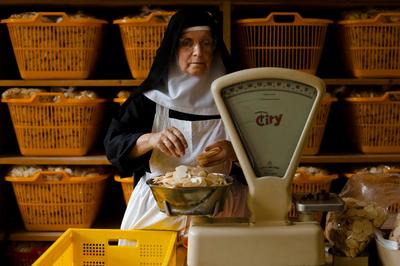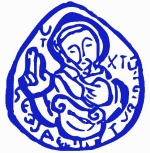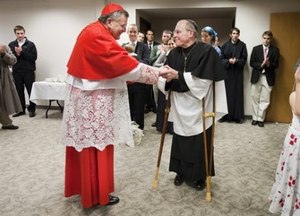 In this photo taken July 28, 2011 Sister Placida scales hosts at the Benedictine Abbey of St. Gertrud's host bakery in Alexanderdorf, Germany, about 50 kilometers (31 miles) south of Berlin. Pope Benedict XVI will not visit the Benedictine Abbey of St. Gertrud, but preparations for his trip are nevertheless in full swing, with the nuns baking thousands of communion wafers to be blessed by the pope at Masses during his September tour. (Photo/Markus Schreiber)
In this photo taken July 28, 2011 Sister Placida scales hosts at the Benedictine Abbey of St. Gertrud's host bakery in Alexanderdorf, Germany, about 50 kilometers (31 miles) south of Berlin. Pope Benedict XVI will not visit the Benedictine Abbey of St. Gertrud, but preparations for his trip are nevertheless in full swing, with the nuns baking thousands of communion wafers to be blessed by the pope at Masses during his September tour. (Photo/Markus Schreiber)
Benedictines: July 2011 Archives
 In this photo taken July 28, 2011 Sister Placida scales hosts at the Benedictine Abbey of St. Gertrud's host bakery in Alexanderdorf, Germany, about 50 kilometers (31 miles) south of Berlin. Pope Benedict XVI will not visit the Benedictine Abbey of St. Gertrud, but preparations for his trip are nevertheless in full swing, with the nuns baking thousands of communion wafers to be blessed by the pope at Masses during his September tour. (Photo/Markus Schreiber)
In this photo taken July 28, 2011 Sister Placida scales hosts at the Benedictine Abbey of St. Gertrud's host bakery in Alexanderdorf, Germany, about 50 kilometers (31 miles) south of Berlin. Pope Benedict XVI will not visit the Benedictine Abbey of St. Gertrud, but preparations for his trip are nevertheless in full swing, with the nuns baking thousands of communion wafers to be blessed by the pope at Masses during his September tour. (Photo/Markus Schreiber)
 Benedictine abbeys are places where the culture of prayer, study, charitable work and arts and crafts can breathe with ease. That's the genius of Saint Benedict and the leadership of monasticism through 1500 years. Few religious orders have such an expansive sense of culture as the Benedictines (or share in across the world). Art aids one in his or seeking God and a better sense of self.
Benedictine abbeys are places where the culture of prayer, study, charitable work and arts and crafts can breathe with ease. That's the genius of Saint Benedict and the leadership of monasticism through 1500 years. Few religious orders have such an expansive sense of culture as the Benedictines (or share in across the world). Art aids one in his or seeking God and a better sense of self.
 Today is the 31st anniversary of the foundation of Fraternity of Communion and Liberation. The narrative of the Fraternity's founding is told in "The Greatest Grace in the History of the Movement" by Giorgio Feliciani (Traces, February 2007). Here's the story.
Today is the 31st anniversary of the foundation of Fraternity of Communion and Liberation. The narrative of the Fraternity's founding is told in "The Greatest Grace in the History of the Movement" by Giorgio Feliciani (Traces, February 2007). Here's the story.
A priest in the direct service of the Holy See, Monsignor Mariano De Nicolò, currently Bishop of Rimini [he retired 3 July 2007], happened to review, as part of his official duties, a file that illustrated and documented the Movement's desiderata. Feeling that these aspirations deserved attention and further study, he suggested to Father Francesco Ricci, who at the time was sharing responsibility for the Movement with Father Giussani [for more about this priest, who died in 1991, see Francesco Ricci. Una passione, cento passioni, San Martino in Strada, Lit. Citienne, 1996], that he consult with Monsignor Giuseppe Lobina, an expert in Canon Law who, along with a solid formal training, had an unusual amount of experience with ecclesiastical praxis.
This advice was promptly taken and, only a few months later, Monsignor Lobina, after acquiring all the necessary information in various meetings with CL figures and Father Giussani himself, was drawing up what would soon be the Statute of the Fraternity, which has remained largely unchanged up to now.
Monsignor Lobina also undertook to find the ecclesiastical authority willing to approve the Movement, and found him in Abbot Martino Matronola, who, as provost [abbot] of the monastery of Montecassino, had the same powers over the surrounding territory as the bishop of a diocese. This acceptance was even more welcome because Father Giussani felt that the concept of his Movement was very close to that of the Benedictines (see Giussani, op.cit., pp. 74-75).
The formal establishment of the Fraternity came shortly thereafter in a very discreet, unassuming way. On July 11, 1980-the solemnity of Saint Benedict, Patron of Europe, on the fifteenth centenary of his birth-a small group of twelve stood together with Father Giussani in front of the Abbot to be constituted as a canonical association. On that same day, Monsignor Matronola,* by a specific formal decree, granted juridical status in the Church to the ecclesial movement called "Fraternity of Communion and Liberation" and approved its statutes and "works of apostolate and individual and social formation," placing it under the "protection of the Immaculate Virgin and our Patron Saint Benedict" (see the Bollettino Diocesano di Montecassino, no. 3, 1980, pp. 223-224).
 Benedictine culture is very interesting. I find this to be true for 2 reasons: after 1500 years of Benedictine monasticism a refined style of humanity and relationship with God is constitutive and monasteries have interesting people as monks and nuns. The famous Rule of Saint Benedict encourages the monk to praise and worship God through a proper ordering of life and interest. Few Benedictines I know are not proficient in works of culture (in the true meaning of the word) like music, vestment making, bee keeping, keeping the library, preparing good lessons for the classroom, cooking, music writing, preaching, study and the like.
Benedictine culture is very interesting. I find this to be true for 2 reasons: after 1500 years of Benedictine monasticism a refined style of humanity and relationship with God is constitutive and monasteries have interesting people as monks and nuns. The famous Rule of Saint Benedict encourages the monk to praise and worship God through a proper ordering of life and interest. Few Benedictines I know are not proficient in works of culture (in the true meaning of the word) like music, vestment making, bee keeping, keeping the library, preparing good lessons for the classroom, cooking, music writing, preaching, study and the like.
 Students of the sacred Liturgy are familiar with the scholarship
and some would say "pioneering work" in the realm of adult baptism and the new (in 1972) Rite of Christian Initiation of Adults (RCIA) by Father Aidan Kavanagh, a Benedictine monk
and priest of the Archabbey of Saint Meinrad.
Students of the sacred Liturgy are familiar with the scholarship
and some would say "pioneering work" in the realm of adult baptism and the new (in 1972) Rite of Christian Initiation of Adults (RCIA) by Father Aidan Kavanagh, a Benedictine monk
and priest of the Archabbey of Saint Meinrad. Today, the monks of Saint Louis Abbey elected for the third time, Abbot Thomas Frerking.
Today, the monks of Saint Louis Abbey elected for the third time, Abbot Thomas Frerking. 
